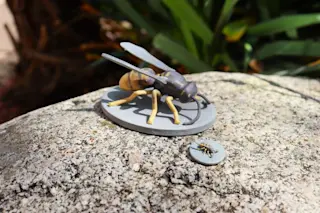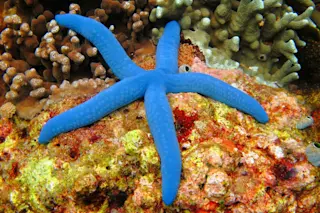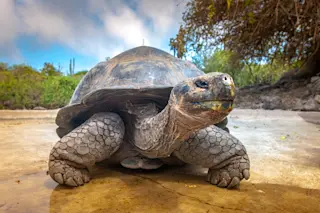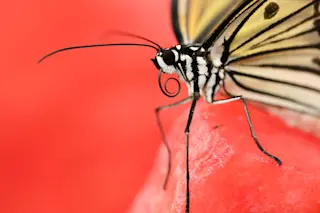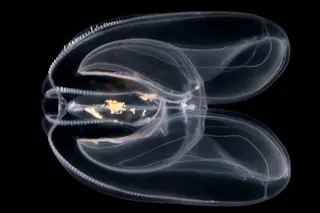Everything you do has a history. You wake up each morning and get out of bed using an anatomy that allowed your ancestors to stand upright at least 4 million years ago. You go to the kitchen and eat cereal with a bowl and spoon that are part of a toolmaking tradition at least 2.5 million years old. As you munch your cereal, you page through the newspaper, which you can understand thanks to a brain capable of language, abstract thought, and prodigious memory—a brain that has been expanding for 2 million years. Until a few decades ago, most of that evolutionary history was hidden from science's view. But these days hardly a month goes by without news of a significant discovery. Paleoanthropologists keep digging up new fossils of our ancestors, and some of those fossils have even yielded DNA fragments. Meanwhile, geneticists have compiled a veritable encyclopedia of evolution—the sequenced human genome—and within a few years they'll be able to compare it with the genome of one of our closest living relatives, the common chimpanzee. Still, what we don't know about our evolution vastly outweighs what we do know. Age-old questions defy a full accounting, and new discoveries introduce new questions. That's not unusual for any field of science, but the eight mysteries on the following pages are intimate ones, because understanding our origins is key to understanding ourselves.
WHO WAS THE FIRST HOMINID?
Time travel would make everything so much easier. imagine that you could drop down by an African lake some 7 million years ago and watch the parade of aardvarks, antelopes, and elephants pass by until, sooner or later, you caught sight of a group of apes. They'd probably look something like chimpanzees—about the same height, with the same coat of hair—but their flat faces and the other odd proportions of their bodies would indicate that they belong to a different species. Perhaps they would turn your way and look you in the eye—a gaze from your most distant hominid ancestors, the first primates to split off from the other apes and begin the family that produced us. Such are the daydreams paleoanthropologists indulge in as they endure blazing heat, merciless sandstorms, and years of fruitless fieldwork. If the earliest hominids were anything like chimps, bonobos, and other living apes, each species may have numbered in the hundreds of thousands, even millions. But few left fossils behind. Most of their bones were scavenged and scattered by hyenas or other animals, and what little remained rotted. When it comes to early hominids, paleoanthropologists have to make do with a few teeth or skull fragments. Yet paleoanthropologists are learning a lot about our origins. Not long ago, the oldest known hominid was Australopithecus afarensis, a species that walked the savannas of East Africa around 3.6 million years ago and is best known from one well-preserved female skeleton found in Ethiopia in 1974 and nicknamed Lucy. In recent years, paleoanthropologists have found perhaps as many as five species that are older than A. afarensis—in some cases much older. Just last year, Michel Brunet of the University of Poitiers, in France, and his team of explorers announced that amid the sand dunes of the Sahara they had found a species between 6 million and 7 million years old: Sahelanthropus tchadensis. These new fossils have thrown cherished orthodoxies into question. "We saw human evolution as a nice, straight line," says Leslie Aiello of University College London. Now some researchers are arguing that human evolution looked more like a bush, with lots of species branching off in different directions. No new orthodoxy has gained enough strength yet to take over the old one. Instead, there's lots of debate. Some paleoanthropologists, for example, have declared Sahelanthropus to be on the line that led to gorillas, not humans. "That's crazy," replies Brunet, who points to small teeth and other key traits that link the creature with hominids rather than apes. But while Brunet is confident he has discovered the oldest known hominid, he doesn't think it's possible yet to make grand pronouncements about the shape of the hominid tree and its various branches. "You can't say that it's bushy," he says. "Maybe it is; we don't know. Our story has just doubled in time, and we're just beginning to understand it."
WHY DO WE WALK UPRIGHT?
For millions of years, the earliest hominids were a lot like other apes. They were short, had tiny brains compared with modern humans, and could not speak or fashion a spear. But there was a profound difference that set them apart: They could stand up and walk. Bipedalism was the first great transformation of our ancestors, coming long before the evolution of all the other things that make us uniquely human. The answer to the question of how our ancestors evolved into bipeds seemed pretty clear for decades. "The long-standing idea was that we became bipedal because we moved out of the forest and onto the savanna, either because we had to look over tall grass or get to isolated stands of trees," says Craig Stanford, a primatologist at the University of Southern California's Jane Goodall Research Center. But in recent years new evidence has thrown that scenario into doubt. "The time-honored idea that a weakling hominid left the safety of the forest for the dangerous savanna and had to live by its wits and stood upright is a nice story, but it's probably fiction," says Stanford. As researchers have looked closer at the older hominid sites, many have concluded that the areas were not savannas at all but a variety of lightly to densely wooded landscapes. Hominids may not have lived in savannas until 2 million to 2.5 million years ago—2.5 million to 3 million years after the earliest known hominids walked on two legs. Now scientists are trying to figure out what evolutionary pressure led hominids to become bipedal in the forest. To answer that question, they have to figure out what upright walking evolved from. Fossils offer some clues, but opinion is divided over what the clues mean. Some paleoanthropologists studying Lucy's skeleton say she walked much as we do, for example, while others say she moved awkwardly on the ground and spent a lot of time in trees. Paleoanthropologists can say even less about the oldest hominids, because they've found hardly anything below the skull. The best clues to our upright origins may come from living apes, although no one knows for sure how much chimpanzees have evolved from the last common ancestor they shared with us. Some primatologists are conducting lab studies of how modern apes knuckle-walk and clamber through trees to see which movements are most like human walking. Other researchers, like Craig Stanford, watch apes in the wild. "Chimpanzees may stand upright on a big limb of a fig tree and pluck figs just overhead," Stanford says. "And when they're on the ground, they'll stand up to pull down branches." He backs a hypothesis originally devised by Kevin Hunt of Indiana University: The earliest hominids may have become specialists in getting food by standing up for short spells, both in the trees or on the ground. It may not seem as heroic as striding out into the savanna, but then again, many great chapters in the book of evolution have been built from such modest changes.
WHY ARE OUR BRAINS SO BIG?
Our brains are not just big—they're grotesquely huge. A typical mammal our size would have a brain one-seventh as large as ours. And big brains are relatively new for hominids. From 7 million to 2 million years ago, our ancestors had brains about the size of a modern chimpanzee's. Hominid brains only began to increase 2 million years ago, and they continued to balloon, in fits and starts, until they neared their present size at least 160,000 years ago. When it comes to explaining this explosion in brain size, scientists agree on one thing: It must have offered a powerful evolutionary advantage. "It costs you an awful lot in terms of energy," says Aiello. "You don't evolve large and expensive organs unless there's a reason." But paleoanthropologists are divided about that reason. One possibility is that bigger brains gave hominids extra information-processing power they could use to make better tools. After all, stone tools unlocked new supplies of food, and so better tool users could support more offspring. Another possibility is that the driving force was hominid social life. Primates living in big groups tend to have bigger brains, possibly because there's an evolutionary advantage to keeping track of other members of your group. And certainly the human brain has evolved into an awesome social computer, able to draw subtle clues about other people's thoughts from their faces in a fraction of a second. On the other hand, big brains may have prompted humans to become more social. For one thing, big brains made children helpless. Hominid kids, then as now, needed years to develop large brains, during which time they depended on adults for high-energy foods. It's possible that the basic shape of the human family as a group of parents, siblings, and grandparents formed to feed the brains of their children.
WHEN DID WE FIRST USE TOOLS?
It is hard to imagine life without tools—finding food with our bare hands, eating it raw with our teeth, seeking a cave or a tree for shelter. In fact, our reliance on tools is reflected in our brains and bodies. The areas of our brains responsible for things like controlling our hands are enlarged compared with other primates. Our hands themselves are different, with proportionately longer thumbs and other anatomic changes that allow us to touch our fingertips and hold tools with more skill. The dawn of tool use was a crucial turning point in human history: It let our ancestors take control of their lives by finding food in places that were off-limits to their ancestors. But scientists still have hardly any clues to how that evolutionary transition took place. The most reliable record of our technological history comes from the tools themselves. The oldest known hominid tools date back 2.5 million years, to a collection of chipped rocks in Ethiopia. They don't look like much, but with them hominids could butcher an elephant or crack open a wildebeest's bones and suck out the marrow. Mentally, they're also a big accomplishment: They require a brain capable of looking at an untouched rock and seeing a tool hiding within it. In recent years, however, some hints have emerged that human technology may have roots reaching back millions of years further into the past. For one thing, chimpanzees and other apes have proved surprisingly gifted at making tools. In order to walk across thorn-covered ground, chimpanzees can fashion sandals out of leaves. In order to eat termites, they can strip sticks to create fishing tools. Unfortunately, a leaf-sandal doesn't leave a fossil. But some researchers believe that the hands of hominids may shed some light on the mystery of tools. For example, Lucy and her A. afarensis fellows lived a million years before the oldest tools. Despite having curved, chimplike fingers, this hominid also had an elongated thumb that could make contact with its fingertips. "There's nothing to say that these creatures couldn't make crude stone tools," says Bernard Wood of George Washington University. It's possible that hominids had already become skilled with wood and other materials 3.5 million years ago, paving the way to mental breakthroughs for making stone tools. As intriguing as this hypothesis may be, however, many researchers think there's not enough evidence to say anything definitive about the evolution of tool use. Tim White, a paleoanthropologist at the University of California at Berkeley, says any speculations "would be strictly X-Files."
HOW DID WE GET MODERN MINDS?
Walking upright, growing a big brain, and even making tools are not enough to make an ape truly human. Consider Homo ergaster, a species that lived in Africa between 1.7 million and 600,000 years ago and probably gave rise to our own species. H. ergaster stood up to six feet tall, had a medium-size brain, and could survive even in arid grasslands thanks to an impressive kit of stone axes and other tools. Despite all that, this species' brain didn't work like ours. For hundreds of thousands of years, H. ergaster was content to use the same set of tools, with few modifications. Putting a stone axe on the end of a stick to make a spear would have allowed these hominids to become much better hunters, and yet this simple idea apparently never occurred to them. Such an idea seems simple only to our modern minds, which can see new possibilities in the world, discover hidden connections, and think and communicate with symbols. Scientists don't yet know how that modern mind came into existence. The question is particularly hard to answer because they can't get into the brain of H. ergaster or any of our other ancestors. Instead, they have to infer what those ancient minds were like by looking at the things they made. The people who painted pictures of mammoths and woolly rhinos in French caves almost 32,000 years ago must have already had minds much like our own. Archaeologists have documented an explosion of expressions of the modern mind after roughly 50,000 years ago, in the form of jewelry, elaborate graves, bone-tipped spears, and other new kinds of tools. The bones of the people who made these things look like our own. They were members of Homo sapiens, complete with long, slender arms and legs, a flat face, a jutting chin, and a high forehead that fronted a big brain. But they were hardly the first people with our anatomy. H. sapiens fossils have been found in Africa from at least 160,000 years ago, and some experts argue that the earliest members of our species may have existed over 200,000 years ago. Richard Klein, a paleoanthropologist at Stanford University, has offered a controversial theory: The modern mind is the result of a rapid genetic change. He puts the date of the change at around 50,000 years ago, pointing out that the rise of cultural artifacts comes after that date, as does the spread of modern humans from Africa. The evolution of the modern mind allowed humans to thrive as never before, Klein argues, and soon even a continent as huge as Africa could not contain their expanding population. Many other paleoanthropologists beg to differ. Sally McBrearty, an archaeologist at the University of Connecticut, believes the evidence shows that the technology and artistic expression of modern humans emerged slowly over hundreds of thousands of years, as humans gradually moved into new habitats and increased their population. She points to a long list of tantalizing clues in Africa that predate Klein's 50,000-year milestone. Humans may have been grinding pigments 250,000 years ago, for example, and researchers have found barbed bone fishing hooks in Central Africa that they estimate are 90,000 years old. Last year scientists in South Africa discovered stones covered with geometrical cross-hatching dating back 77,000 years. Klein dismisses the evidence for such slow-fuse change as paltry and misleading. "It's a little bit here, it's a little bit there. Most sites don't have anything like this at all, but when you get to 50,000 years ago, they all do. Then you get real art—not stuff you can argue about whether it shows some form of symbolism—and elaborate graves and houses and the rest of it." A resolution to this debate may be waiting in Africa, at archaeological sites scattered across the continent. "We know what we'd like to find and where we ought to look for it," says McBrearty. "But are we going to have the money and the perseverance to mount the assault and come up with the goods?"
WHY DID WE OUTLIVE OUR RELATIVES?
Humans today are driving other species toward extinction at a disturbing pace—a quarter of all mammal species, for example, are officially listed as threatened. But the evidence from fossils suggests that this wave of extinctions has been rising for thousands of years. And there's a grim irony in the possibility that two of the first species to fall victim to us may have been our closest relatives. Studies on human mitochondrial DNA indicate that all humans alive today can trace their ancestry back to members of Homo sapiens who lived in Africa roughly 150,000 years ago. At the time, there were two other hominid species. Members of Homo neanderthalensis (Neanderthals), who lived in Europe, have a reputation as lumbering brutes, but they had brains as big as or bigger than those of humans and awesome hunting skills that helped them survive cyclic ice ages for half a million years or more. In Asia, Homo erectus survived for about 1.5 million years. And yet not long after H. sapiens spread from Africa, both of these species vanished. Our close kinship with these hominids makes their disappearance all the more puzzling. "It's very difficult to get your head around the idea that there could be another species so closely related to us, but isn't us," says McBrearty. It wasn't very long ago, geologically speaking, when our ancestors came face to face with these other species, and yet scientists still know little about the encounter. About H. erectus, all they can say is that the youngest H. erectusfossils, Indonesian skulls from perhaps 50,000 years ago, come from a time when our own species had already settled in Asia and moved on to Australia. "We don't know what the hell is going on there," says Klein. "We need more fossils with good dates. It'll come—within a decade we'll know something more about this." Neanderthals left behind more hints, although the picture is still far from clear. Scientists have isolated six fragments of Neanderthal DNA and have concluded that the Neanderthal did not interbreed much—if at all—with H. sapiens.Neanderthals appear to have clung to existence for 15,000 years after encountering our own species in Europe. But over time they became rarer and rarer, until they could be found only in isolated mountain valleys. And then they could be found nowhere at all. Over the years, scientists have tried to explain the disappearance of Neanderthals and H. erectus with everything from warfare to exotic viruses that their H. sapiens relatives brought with them from Africa. But the cause of their demise could have been far more subtle. Even if our species had just a slight evolutionary edge over the other hominids, the effect could have been devastating, given enough time. It's possible, for example, that humans benefited from long-distance trade and better tools, allowing them to withstand droughts, ice ages, and other hard times better than their competitors. Our ancestors may have had just a few more children in each generation, and gradually they took over the best places for hunting and living. After a few hundred generations, they unwittingly squeezed their cousins out of existence. "It may have been something as simple as modern humans having better clothing," says Leslie Aiello.
WHAT GENES MAKE US HUMAN?
In April 2003, geneticists finished sequencing the human genome, and now they're well on their way to decoding the genome of one of our closest relatives, the common chimpanzee. The sight of these two sequences placed side by side is astonishing. For thousands of positions at a stretch, their codes are identical. Recently Morris Goodman, a biologist at the Wayne State University School of Medicine, and his colleagues analyzed the portions of DNA that are responsible for the structure of proteins. In this crucial part of the genome, humans and chimps were 99.4 percent identical. In other words, much of what makes us uniquely human may be found in just .6 percent of our genome. That tiny fraction will be the focus of a huge amount of research in years to come. "There will be a gold mine of information," predicts Sean Carroll, a geneticist at the University of Wisconsin and an investigator with the Howard Hughes Medical Institute. As the differences between humans and chimps come to light, for instance, medicine will be revolutionized. Scientists hope to find the genetic differences that explain why chimpanzees don't get AIDS, Alzheimer's, and other diseases that plague humans. Scientists will also be searching the two genomes for clues to how and why humans evolved traits that distinguish us from chimpanzees, including a bipedal body, a big brain, and language. A taste of things to come is the recent study of a gene called FOXP2. People who inherit mutant forms of FOXP2 have trouble speaking and understanding grammar. Scientists have reconstructed the evolutionary history of the gene by comparing the subtle variations in FOXP2 that different people carry. The researchers found that in the past 200,000 years, the gene underwent an intense burst of evolutionary selection. It's possible that changes to this gene may have helped prompt the transformation of simple apelike grunts into language. But it would be a mistake to think that any single gene will tell us much about human nature, or even just the ability to talk. "We're just not going to have two or three speech genes and that's the end of the story," says Carroll. "It's going to be much more subtle than that." The early evidence already suggests that perhaps several thousand human genes have undergone intense natural selection since our ancestors split with the chimp lineage. And those genes can only build a modern human being by cooperating with one another rather than working alone. This comes as no surprise to scientists who have studied the evolution of other animals. "We look for simple answers, but we almost always find a mess," says Carroll.
HAVE WE STOPPED EVOLVING?
It has been an amazing run: Over 7 million years our lineage has evolved from diminutive apes to the planet's dominant species. We've evolved brains that are capable of things never achieved on our planet, and perhaps in the universe. Why shouldn't we continue evolving more powerful brains? It's easy to think that we'll just keep marching ahead, that in another million years we'll have gigantic brains like out of some episode of Star Trek. But scientists can't say where we're headed. It's even possible that we've reached an evolutionary dead end. Consider the fact that the human brain hasn't expanded all that much in at least 160,000 years. You might think that if bigger brains meant more intelligence, natural selection would still be inflating them today. But big brains have their drawbacks. Like an expanding computer network, a growing brain needs more and more wiring to connect its processors together. The human brain may be reaching the edge of this computational limit. Big brains also make a lot of demands on the human body—particularly the bodies of pregnant women. A woman's birth canal has to be wide enough for a big-brained baby to get out. But there's a limit to how wide the female pelvis can become: If it became too wide, women would struggle to walk upright. That constraint may make it impossible for the human brain to get any bigger. The only way to know the answer to this particular question, however, may be to wait for the future to become the past. "One of the reasons why people are fascinated with human evolution is because it's about where we came from and where we're going," says Aiello. "But we don't know where we're going. It's too much of a lottery."
Getting a Grip
The human hand is dramatically different from that of the chimpanzee, our closest living relative. Over the past 7 million years, both the fingers and the palms of our hominid ancestors became shorter, and their thumbs became more flexible. These changes, along with the greatly expanded motor and sensory capacity in our brains, allow us to use a wide range of power, precision, and hook grips and hence an infinite variety of tools. But the story of hand evolution is still a murky one. Despite the difference in the way its hands are shaped, a chimp has considerable dexterity. It can flex or fold its fingers in a hook position or grasp small objects between its thumb and the side of its index finger. And fossils of hominid hands from 3.5 million years ago look chimplike in some ways and humanlike in others, making it unclear just how nimble their fingers were.




